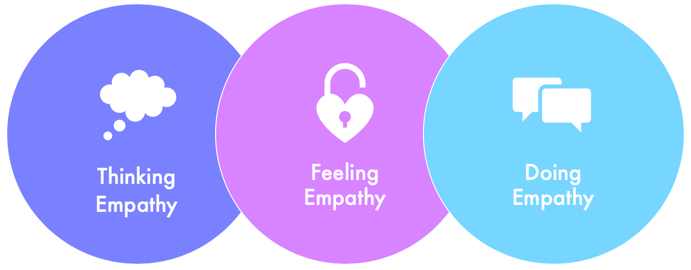Yes! There is actually more than one way to effectively measure empathy—and one way that is a waste of time.
Before we dive into measuring empathy, it is first critical to understand there are 3 dimensions of empathy:
- Cognitive (thinking)
- Affective (feeling)
- Behavioral (doing)

When choosing a research method or instrument, ensure that it measures the dimension(s) you want to study. Not every empathy instrument measures all 3 dimensions.
Methods for Measuring Empathy
First, here’s how NOT to measure empathy:
Self-Assess employees
Don’t ask employees to assess their own empathy. Researchers have shown that humans are not good judges of their own empathy. In 2018, a group of researchers asked doctors to self-assess their empathy—and then had the same doctors’ own patients rate their doctors’ empathy. There was zero correlation.
Worse, researchers find that people with low empathy overestimate it and those with high empathy underestimate it. (See the Dunning-Kruger Effect.)
Here are some BETTER ways to measure empathy:
Ask customers
Simply ask your customers to score your employees. It turns out, they are pretty good at judging whether or not they were treated with empathy. Use follow-up qualitative research to more deeply understand why empathy goes wrong (and right).
To measure employee empathy at the individual and transaction level, you might ask the following types of questions* in a customer survey:
- In your most recent experience with our customer service center, was the customer service representative empathetic?
- Did you feel they engaged with you on a human level?
- Did you feel that they understood your needs?
- Did you feel they valued your time?
- Overall, do you feel [company] values you as a customer?
*Adapted from Forrester’s “Use Emotion to Beat Customer Service Stagnation” (2019).
Observe employees
Observe your customers and employees interacting with each other—and then score them. Apply natural language processing (NLP) to recorded phone calls to detect empathy opportunities and employees’ empathic responses.
Some vendors even provide this information in real-time so that employees can adjust their behavior.
See: From Data to Wellness: How Text Analytics Can Boost Employee Wellbeing
take employees to the Lab
Use neurometrics or biometrics to scan employees’ brains or skin reactions. Neuroscientists have pinpointed the part of the brain responsible for empathy, called the mirror neuron system (MNS). In fMRI experiments, scientists discovered that more empathic people use their MNS more than less empathic people. (This one is pretty intrusive, so probably not a realistic option.)
In Conclusion
Alone, none of the above instruments are perfect.
You can ask customers to score your employees’ level of empathy—however, you weren’t there to know what the employee actually said or how they behaved.
You can observe your customers and employees interacting—however, you cannot be 100% confident as to how customers interpreted an employee’s expression of empathy.
It’s best to use a combination of self-reported and observational data to get a complete picture of your employees’ level of empathy.
See also: What Is Empathy… Really?
See also: Can Empathy Be Taught?